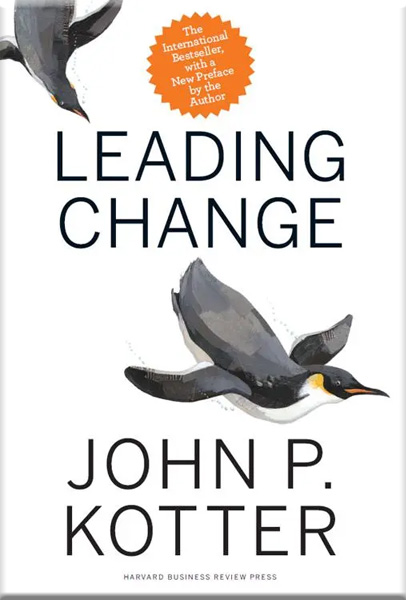 "Leading Change" is a book by Harvard Business School professor John P. Kotter that provides a practical framework for leading organizational change. The book outlines an eight-step process for effectively managing change initiatives, with a focus on transforming organizations to meet the challenges of today's rapidly changing business environment.
"Leading Change" is a book by Harvard Business School professor John P. Kotter that provides a practical framework for leading organizational change. The book outlines an eight-step process for effectively managing change initiatives, with a focus on transforming organizations to meet the challenges of today's rapidly changing business environment.
The eight steps of Kotter's change model are:
- Establishing a sense of urgency: The first step in Kotter's model is to establish a sense of urgency among stakeholders. This involves creating a compelling case for change that highlights the risks and opportunities facing the organization. Leaders must communicate the urgency of the situation in a way that motivates people to take action, and encourages them to see the benefits of change.
- Creating a guiding coalition: The second step is to build a team of influential individuals who have the credibility and skills to drive change. This coalition should be diverse, with members representing different departments, functions, and levels of the organization. The guiding coalition should be empowered to make decisions, and should have the support of senior leadership.
- Developing a vision and strategy: The third step is to develop a clear and inspiring vision for the future, and a comprehensive strategy for achieving it. The vision should be based on the organization's values and purpose, and should be communicated in a way that resonates with stakeholders. The strategy should be flexible and adaptive, and should involve clear goals, timelines, and performance metrics.
- Communicating the change vision: The fourth step is to communicate the vision and strategy to all stakeholders, ensuring that everyone understands and supports the change. Leaders should use multiple channels and methods to communicate the vision, including town hall meetings, videos, and social media. They should also address any concerns or questions that stakeholders may have, and encourage open and honest feedback.
- Empowering others to act on the vision: The fifth step is to empower others to take action on the vision by removing obstacles, providing resources, and creating a supportive environment. Leaders should delegate authority and responsibility, and should foster a culture of innovation and experimentation. They should also provide training and development opportunities to help people build the skills and knowledge they need to succeed.
- Creating short-term wins: The sixth step is to generate visible, meaningful results early in the change process to build momentum and demonstrate the value of the change effort. Leaders should identify quick wins that are achievable in the short term, and should celebrate these successes with stakeholders. They should also communicate these wins widely, and use them to generate enthusiasm and support for the change.
- Consolidating gains and producing more change: The seventh step is to use the momentum generated by early wins to drive further change, consolidating gains and embedding new behaviours and practices. Leaders should build on the successes of the early wins, and should use these gains to tackle more complex and challenging issues. They should also continue to communicate and celebrate successes, and should use these successes to inspire and motivate stakeholders.
- Anchoring new approaches in the organization's culture: The final step is to ensure that new behaviours and practices are embedded in the organization's culture, making them a natural part of the way things are done. Leaders should institutionalize the changes by aligning systems, processes, and structures with the new behaviours and practices. They should also communicate the importance of the changes to the organization's culture, and should encourage and reward behaviours that support the new approaches.
Overall, "Leading Change" is a highly regarded resource for anyone involved in organizational change, offering practical advice and actionable insights for effectively managing complex change initiatives.
Read the book now - https://talk2us.link/msl

